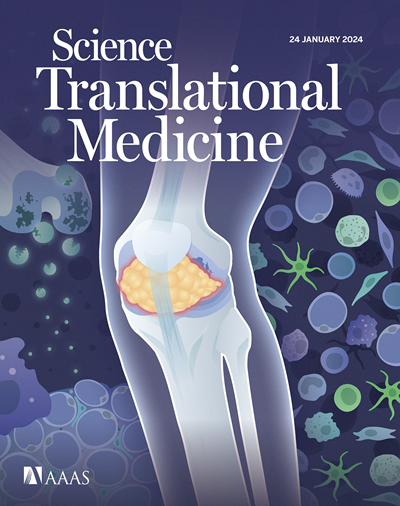患者衍生的UBA5相关脑病模型识别神经发育缺陷,并强调潜在的治疗途径
IF 15.8
1区 医学
Q1 CELL BIOLOGY
引用次数: 0
摘要
UBA5编码ufmyination级联的E1酶,在内质网(ER)的稳态中起重要作用。UBA5相关脑病的临床表型包括发育迟缓、癫痫和智力残疾。迄今为止,还没有人源化的神经元模型来研究UBA5致病变异的细胞和分子后果。我们开发并鉴定了两名UBA5复合杂合变异患者的患者来源的皮质类器官培养物。两者都有相同的错义变体,它编码一个半胚等位基因(p.A371T),以及一个无义变体(p.G267*或p.A123fs*4)。百日类器官单细胞RNA测序发现gaba能中间神经元发育缺陷。我们证明了异常的神经元放电和患者来源的类器官大小的减少。在机制上,我们发现在工程的U87-MG细胞和表达UBA5致病变异的患者来源的类器官中,内质网稳态随着未折叠蛋白反应途径的加剧而受到干扰。我们还评估了两种增强UBA5蛋白丰度以拯救异常分子和细胞表型的潜在治疗方式。我们评估了SINEUP(一种提高翻译效率的长链非编码RNA)和CRISPRa(一种改进的CRISPR-Cas9方法,提高转录效率以增加UBA5蛋白的产生)。我们的研究提供了一个人性化的模型,允许进一步研究大脑中的UBA5变异,并强调了缓解这种罕见的发育障碍的细胞畸变的有希望的方法。本文章由计算机程序翻译,如有差异,请以英文原文为准。
Patient-derived models of UBA5- associated encephalopathy identify defects in neurodevelopment and highlight potential therapeutic avenues
求助全文
通过发布文献求助,成功后即可免费获取论文全文。
去求助
来源期刊

Science Translational Medicine
CELL BIOLOGY-MEDICINE, RESEARCH & EXPERIMENTAL
CiteScore
26.70
自引率
1.20%
发文量
309
审稿时长
1.7 months
期刊介绍:
Science Translational Medicine is an online journal that focuses on publishing research at the intersection of science, engineering, and medicine. The goal of the journal is to promote human health by providing a platform for researchers from various disciplines to communicate their latest advancements in biomedical, translational, and clinical research.
The journal aims to address the slow translation of scientific knowledge into effective treatments and health measures. It publishes articles that fill the knowledge gaps between preclinical research and medical applications, with a focus on accelerating the translation of knowledge into new ways of preventing, diagnosing, and treating human diseases.
The scope of Science Translational Medicine includes various areas such as cardiovascular disease, immunology/vaccines, metabolism/diabetes/obesity, neuroscience/neurology/psychiatry, cancer, infectious diseases, policy, behavior, bioengineering, chemical genomics/drug discovery, imaging, applied physical sciences, medical nanotechnology, drug delivery, biomarkers, gene therapy/regenerative medicine, toxicology and pharmacokinetics, data mining, cell culture, animal and human studies, medical informatics, and other interdisciplinary approaches to medicine.
The target audience of the journal includes researchers and management in academia, government, and the biotechnology and pharmaceutical industries. It is also relevant to physician scientists, regulators, policy makers, investors, business developers, and funding agencies.
 求助内容:
求助内容: 应助结果提醒方式:
应助结果提醒方式:


